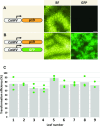Agrobacterium-mediated transient transformation of Flaveria bidentis leaves: a novel method to examine the evolution of C4 photosynthesis
- PMID: 39731143
- PMCID: PMC11674322
- DOI: 10.1186/s13007-024-01306-z
Agrobacterium-mediated transient transformation of Flaveria bidentis leaves: a novel method to examine the evolution of C4 photosynthesis
Abstract
The genus Flaveria has been studied extensively as a model for the evolution of C4 photosynthesis. Thus far, molecular analyses in this genus have been limited due to a dearth of genomic information and the lack of a rapid and efficient transformation protocol. Since their development, Agrobacterium-mediated transient transformation protocols have been instrumental in understanding many biological processes in a range of plant species. However, this technique has not been applied to the genus Flaveria. Here, an efficient protocol for the Agrobacterium-mediated transient transformation of the leaves of the C4 species Flaveria bidentis is presented. This technique has the distinct advantages of rapid turnaround, the ability to co-transform with multiple constructs, and the capacity to assay coding and non-coding regions of Flaveria genomes in a homologous context. To illustrate the utility of this protocol, the quantitative transcriptional regulation of phosphoenolpyruvate carboxylase, the primary carboxylase of C4 plants, was investigated. A 24 bp region in the ppcA1 proximal promoter was found to elicit high levels of reporter gene expression. The Agrobacterium-mediated transient transformation of F. bidentis leaves will accelerate the understanding of the biology and evolution of C4 photosynthesis in the genus Flaveria as well as in other C4 lineages.
Keywords: Flaveria; C4 photosynthesis; Evolution of C4 photosynthesis; Phosphoenolpyruvate carboxylase; Transient transformation.
© 2024. The Author(s).
Conflict of interest statement
Declarations. Ethics approval and consent to participate: Not applicable. Consent for publication: Not applicable. Competing interests: The authors declare no competing interests.
Figures








Similar articles
-
The Promoter of the Gene Encoding the C4 Form of Phosphoenolpyruvate Carboxylase Directs Mesophyll-Specific Expression in Transgenic C4 Flaveria spp.Plant Cell. 1997 Apr;9(4):479-489. doi: 10.1105/tpc.9.4.479. Plant Cell. 1997. PMID: 12237362 Free PMC article.
-
Evolution of the C4 phosphoenolpyruvate carboxylase promoter of the C4 species Flaveria trinervia: the role of the proximal promoter region.BMC Plant Biol. 2008 Jan 21;8:4. doi: 10.1186/1471-2229-8-4. BMC Plant Biol. 2008. PMID: 18208593 Free PMC article.
-
A MEM1-like motif directs mesophyll cell-specific expression of the gene encoding the C4 carbonic anhydrase in Flaveria.J Exp Bot. 2017 Jan;68(2):311-320. doi: 10.1093/jxb/erw475. Epub 2016 Dec 30. J Exp Bot. 2017. PMID: 28040798 Free PMC article.
-
Evolution of c4 phosphoenolpyruvate carboxylase. Genes and proteins: a case study with the genus Flaveria.Ann Bot. 2004 Jan;93(1):13-23. doi: 10.1093/aob/mch003. Epub 2003 Nov 26. Ann Bot. 2004. PMID: 14644912 Free PMC article. Review.
-
A scheme for C4 evolution derived from a comparative analysis of the closely related C3, C3-C4 intermediate, C4-like, and C4 species in the genus Flaveria.Plant Mol Biol. 2022 Nov;110(4-5):445-454. doi: 10.1007/s11103-022-01246-z. Epub 2022 Feb 4. Plant Mol Biol. 2022. PMID: 35119574 Review.
Cited by
-
An Efficient Agrobacterium-Mediated Transient Transformation System Using In Vitro Embryo-Derived Seedlings for Gene Function Elucidation in Paeonia ostii.Plants (Basel). 2025 Aug 12;14(16):2498. doi: 10.3390/plants14162498. Plants (Basel). 2025. PMID: 40872121 Free PMC article.
References
-
- Osmond CB, Winter K, Ziegler H. Functional significance of different pathways of CO2 fixation in photosynthesis. In: Lange OL, Nobel PS, Osmond CB, Ziegler H, editors. Physiological plant ecology II. Encyclopedia of plant physiology. Berlin: Springer; 1982. p. 479–547.
-
- Hattersley PW. The distribution of C3 and C4 grasses in Australia in relation to climate. Oecologia. 1983;57:113–28. - PubMed
-
- Mitchell PL, Sheehy JE. Supercharging rice photosynthesis to increase yield. New Phytol. 2006;171:688–93. - PubMed
-
- Sage RF, Christin P-A, Edwards EJ. The C4 plant lineages of planet Earth. J Exp Bot. 2011;62:3155–69. - PubMed
-
- Sage RF, Monson RK, Ehleringer JR, Adachi S, Pearcy RW. Some like it hot: the physiological ecology of C4 plant evolution. Oecologia. 2018;187:941–66. - PubMed
Grants and funding
LinkOut - more resources
Full Text Sources
Miscellaneous

